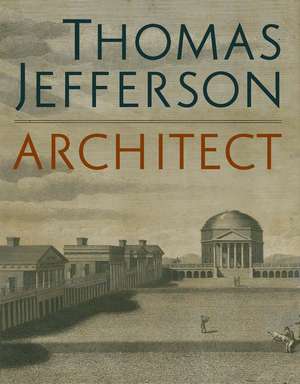Thomas Jefferson, Architect: Palladian Models, Democratic Principles, and the Conflict of Ideals
Editat de Lloyd DeWitt, Corey Piper Introducere de Erik H Neil Contribuţii de Howard Burns, Guido Beltramini, Richard Guy Wilson, Barry Bergdoll, Louis P. Nelson Autor Mabel O. Wilsonen Limba Engleză Hardback – 5 noi 2019
A compelling reassessment of Thomas Jefferson’s architecture that scrutinizes the complex, and sometimes contradictory, meanings of his iconic work
Renowned as a politician and statesman, Thomas Jefferson (1743–1826) was also one of the premier architects of the early United States. Adept at reworking Renaissance—particularly Palladian—and Enlightenment ideals to the needs of the new republic, Jefferson completed visionary building projects such as his two homes, Monticello and Poplar Forest; the Capitol building in Richmond; and the University of Virginia campus. Featuring a wealth of archival images, including models, paintings, drawings, and prints, this volume presents compelling essays that engage broad themes of history, ethics, philosophy, classicism, neoclassicism, and social sciences while investigating various aspects of Jefferson’s works, design principles, and complex character.
In addition to a thorough introduction to Jefferson’s career as an architect, the book provides insight into his sources of inspiration and a nuanced take on the contradictions between his ideas about liberty and his embrace of slavery, most poignantly reflected in his plan for the academical village at the University of Virginia, which was carefully designed to keep enslaved workers both invisible and accessible. Thomas Jefferson, Architect offers fresh perspectives on Jefferson’s architectural legacy, which has shaped the political and social landscape of the nation and influenced countless American architects since his time.
Renowned as a politician and statesman, Thomas Jefferson (1743–1826) was also one of the premier architects of the early United States. Adept at reworking Renaissance—particularly Palladian—and Enlightenment ideals to the needs of the new republic, Jefferson completed visionary building projects such as his two homes, Monticello and Poplar Forest; the Capitol building in Richmond; and the University of Virginia campus. Featuring a wealth of archival images, including models, paintings, drawings, and prints, this volume presents compelling essays that engage broad themes of history, ethics, philosophy, classicism, neoclassicism, and social sciences while investigating various aspects of Jefferson’s works, design principles, and complex character.
In addition to a thorough introduction to Jefferson’s career as an architect, the book provides insight into his sources of inspiration and a nuanced take on the contradictions between his ideas about liberty and his embrace of slavery, most poignantly reflected in his plan for the academical village at the University of Virginia, which was carefully designed to keep enslaved workers both invisible and accessible. Thomas Jefferson, Architect offers fresh perspectives on Jefferson’s architectural legacy, which has shaped the political and social landscape of the nation and influenced countless American architects since his time.
Published in association with the Chrysler Museum of Art
Exhibition Schedule:
Chrysler Museum of Art, Norfolk
(October 19, 2019–January 19, 2020)
(October 19, 2019–January 19, 2020)
Preț: 273.80 lei
Preț vechi: 300.57 lei
-9% Nou
Puncte Express: 411
Preț estimativ în valută:
52.39€ • 54.85$ • 43.35£
52.39€ • 54.85$ • 43.35£
Carte indisponibilă temporar
Doresc să fiu notificat când acest titlu va fi disponibil:
Se trimite...
Preluare comenzi: 021 569.72.76
Specificații
ISBN-13: 9780300246209
ISBN-10: 030024620X
Pagini: 208
Ilustrații: 88 color + 86 b-w illus.
Dimensiuni: 216 x 276 x 24 mm
Greutate: 1.2 kg
Editura: Yale University Press
Colecția Yale University Press
ISBN-10: 030024620X
Pagini: 208
Ilustrații: 88 color + 86 b-w illus.
Dimensiuni: 216 x 276 x 24 mm
Greutate: 1.2 kg
Editura: Yale University Press
Colecția Yale University Press
Recenzii
“A new perspective, highlighting the neoclassical influences on the contention between Jefferson’s ideology of liberty and property.”—Kate Mazade, The Architect’s Newspaper
“An outstanding survey of Jefferson’s work.”—CHOICE
“An outstanding survey of Jefferson’s work.”—CHOICE
Notă biografică
Lloyd DeWitt is the chief curator and Irene Leache Curator of European Art. Corey Piper is Brock Curator of American Art, both at the Chrysler Museum of Art.
Guido Beltramini is director of the Centro Internazionale di Studi Architettura Andrea Palladio and the Palladio Museum. Barry Bergdoll is Meyer Schapiro Professor of Art History at Columbia University. Howard Burns is president of the Scientific Committee of the Centro Internazionale di Studi Architettura Andrea Palladio. Erik H. Neil is director of the Chrysler Museum of Art. Louis P. Nelson serves as professor of architectural history and vice provost for academic outreach at the University of Virginia. Mabel O. Wilson is professor of architectural design and history/theory at Columbia University and senior fellow with the Columbia University Institute for Research in African American Studies. Richard Guy Wilson serves as Commonwealth Professor, Architectural History at the University of Virginia School of Architecture.
Guido Beltramini is director of the Centro Internazionale di Studi Architettura Andrea Palladio and the Palladio Museum. Barry Bergdoll is Meyer Schapiro Professor of Art History at Columbia University. Howard Burns is president of the Scientific Committee of the Centro Internazionale di Studi Architettura Andrea Palladio. Erik H. Neil is director of the Chrysler Museum of Art. Louis P. Nelson serves as professor of architectural history and vice provost for academic outreach at the University of Virginia. Mabel O. Wilson is professor of architectural design and history/theory at Columbia University and senior fellow with the Columbia University Institute for Research in African American Studies. Richard Guy Wilson serves as Commonwealth Professor, Architectural History at the University of Virginia School of Architecture.
